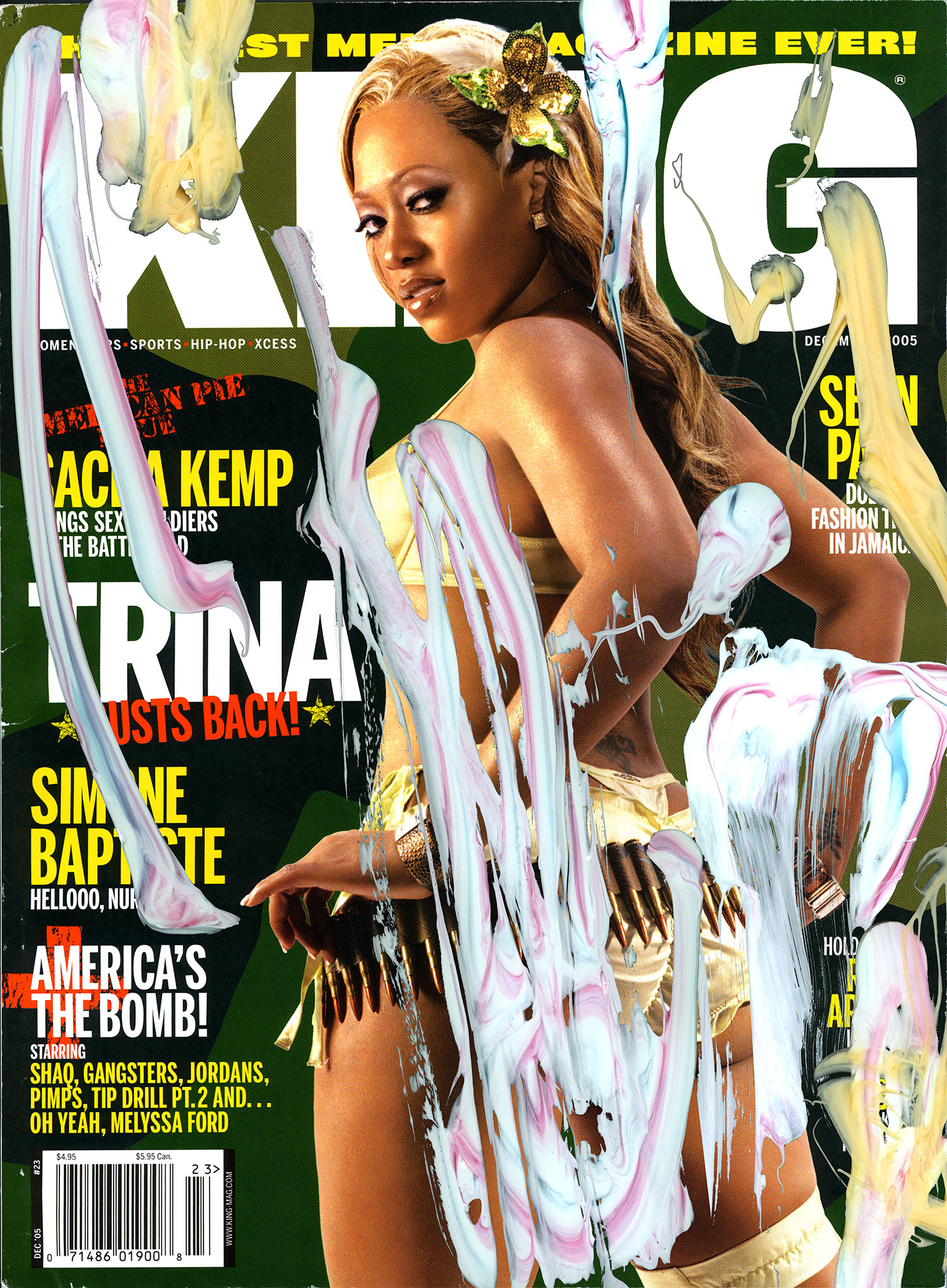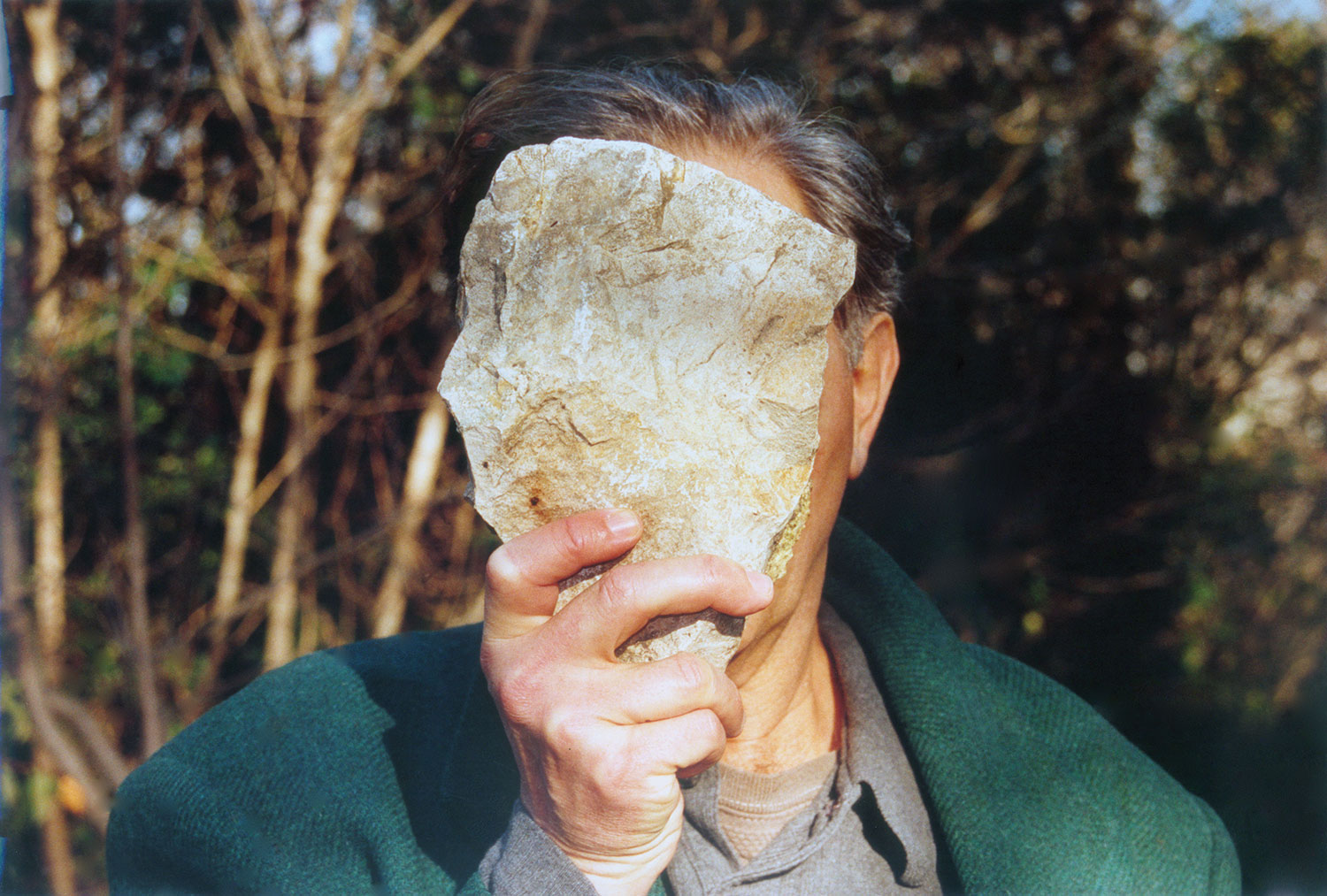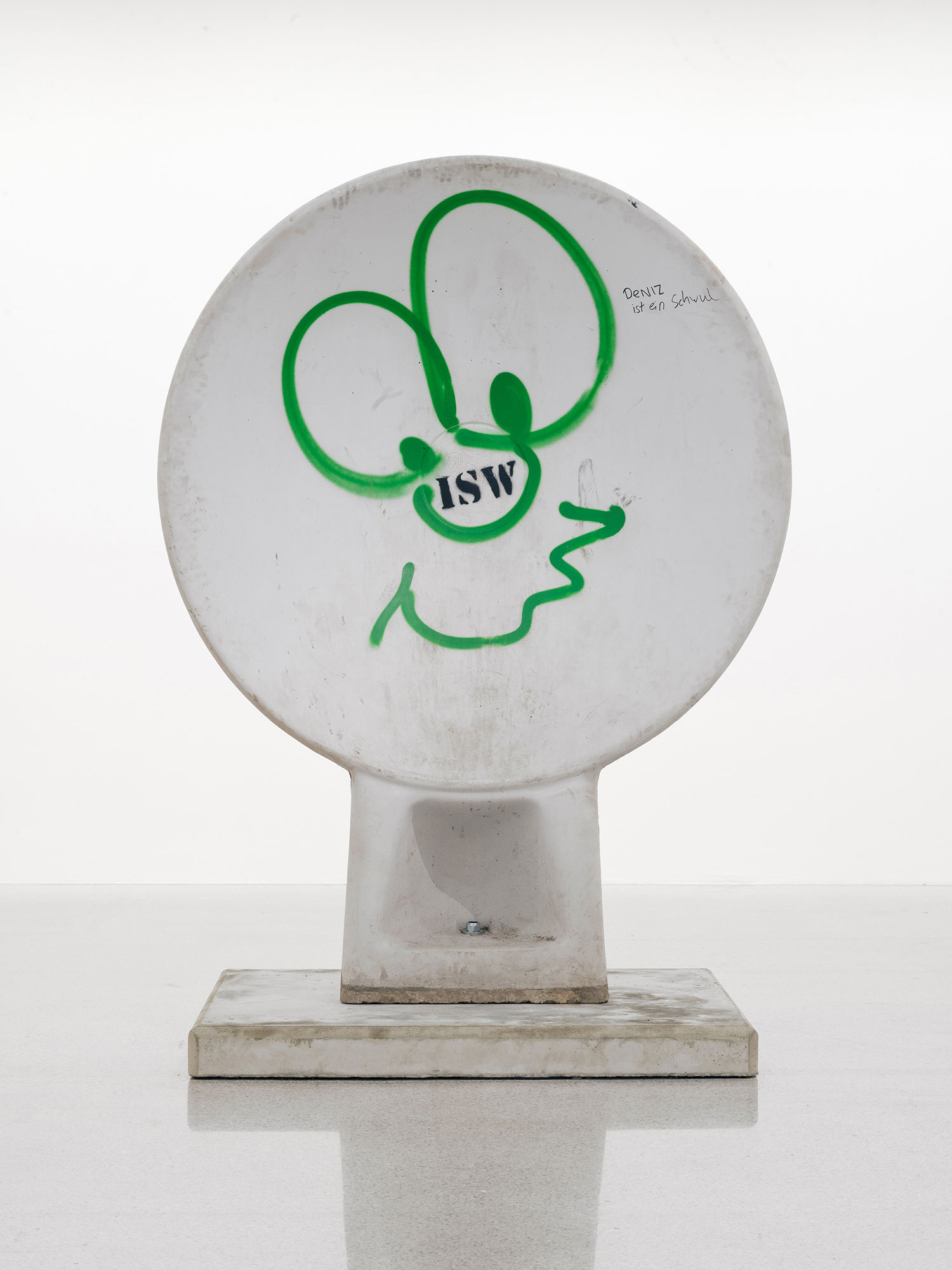
Sadie Benning’s early black-and-white videos convey the familiar postadolescent restlessness and ennui experienced by teenagers when confined to the banal spaces of domesticity and the solitude of the bedroom. Made between 1989 and 1992, when Benning was only fifteen years old, the poignant narratives are part diary and part performance: communicated through direct address, disembodied voice-overs and handwritten messages on tiny scraps of paper. Scenes are composed of household objects, everyday knickknacks and toys immediately at hand — small, sculptural tableaus interspersed with Benning’s own image: close-up shots of the artist’s eyes, lips and other parts of her body. Notably shot on a Fisher Price Pixelvision camcorder, the black-bordered images are characteristically grainy and raw, with a shallow depth of field that presents the picture in stark, graphic contrast or runny grays depending on the distance of the lens from the object being recorded. When captured by the crude cassette-tape stock of the Pixelvision camcorder, the most banal forms and spaces — a Venetian blind, a bedroom corner, an empty sofa — are rendered strangely palpable and amorphously distant. Like invisible ink, the images appear in a state of perpetual evaporation. Today such “experimental” aesthetic qualities manifest as analog nostalgia, in the superficial filters and layers that easily slide onto so many forms of digital media. However, in 1989, the obstinate effects of the camera’s technical limitations — which often demanded that young Benning produce her videos with a slowness and claustrophobic proximity to the camera — also allowed the artist to confront the alienation she was experiencing while growing up queer in inner-city Milwaukee. As experiments in movement, scale and spatial orientation, these early formal meditations acted as a kind of structural model for envisioning identity as a fluid and durational process — one that was not bound to fixed notions of the self. In this early moment, Benning responded to the demands of a purely image-based means of representation by turning to more bodily, and specifically haptic, negotiations of identity. It is her hand — the foremost instrument by which she produced meaning, through the activities of drawing, writing, arranging and holding the camera — that frequently appears as a visual motif in videos such as If Every Girl Had a Diary (1990), where it fills the entire screen as a luminous apparition against a stark black background. Moving slowly from open palm to closed fist, it appears not so much as a hand but a spectral, shape-shifting abstraction.

In Benning’s two-channel video animation Play Pause, 2001–2006, physical, material and bodily contingencies play out in quirky illustrations that are set within the city’s most transient spaces: an ATM, a bus stop, a nightspot called Ze Bar. Both people and architecture are drawn with thick, dark lines that have a lo-fi, globular quality, and the intense flatness establishes a democratic field of vision: individual bricks of a building, a sneakered foot or a head of hair all seem to carry equal visual weight. And yet, these objects also appear on the verge of spatial autonomy, as if they will suddenly take flight from the bodies they are attached to. While the narrative makes clear that sex and desire motivate these transitory figures and spaces, the jittery and wavering way in which they are drawn reveals a different insight into Benning’s corporeal relationship to the gestural mark or line. “The movement you make when you’re drawing, it’s like nerves. Something really bodily is happening” [Tina Kukielski, “Interview with Sadie Benning,” Mousse, December 2011]. Indeed, these early drawings and paintings exhibit what David Joselit has described as “eccentric figuration” — painting that engages more visceral registers by playfully disturbing stylistic conventions of mimesis and abstraction. These irresolute forms provide a vital means of representation, enabling the formal expression of “individual particularity without hardening into a sign or stereotype” [Painting 2.0: Expression in the Information Age, Museum Brandhorst, 2016, p. 102].
If this aesthetic development arises out of the repressive influence of modern media and spectacle culture, as Joselit seems to suggest, paradoxically, themes of media and spectacle figure most prominently for Benning when the artist’s emphatic lines experience a definitive shift from “eccentric figuration” to more ostensibly abstract and monochromatic works. Benning’s series of “Transitional Effects” paintings, made between 2005 and 2011, directly translates the two-dimensional effects of film editing techniques — such as wipes, fades and cuts — into the three-dimensional space of sculpture. More specifically, they are sculptural paintings assembled from plaster-covered MDF pieces that have been laboriously sanded and painted — a technique that is now ubiquitous in Benning’s production. The overall effect of the artist’s transitional paintings does not mirror the fleeting frames of filmic media as much as arouse the viewer’s desire to touch the flesh-like contours or pull apart the imprecise edges. Painted with monochromatic hues like “Ace Fluorescent Rocket Red” and “Rustoleum Gloss Hunter Green,” these panels also appear as a sly queering of the sterile industrial and serial concerns assigned to Minimalism proper. Instead, these works are more closely aligned with the bodily labor and hand-sanded contours of lesser-known minimalist figures like Anne Truitt.

In Benning’s recent works, her ongoing investigations into the intricate relationship between seeing and feeling extend beyond the formation of her personal identity, into larger social and political spheres. In works like Zig Zag Yellow, 2014, the high-contrast colors and buzzy lightning-bolt pattern loosely recall the formal aesthetics of Op art — a movement wholly informed by the scientific intricacies of how retinal effects induce bodily responses, specifically by giving the illusion of movement. Made again with the same sanded, rounded-edge, wooden-jigsaw-puzzle process, Zig Zag Yellow evokes animated cartoon explosions rather than the heady theories of perception that formalized Op art in the mid-1960s. The imagery is a loose interpretation of diagrammatic charts and graphs inspired by “fuzzy math” — a term from set theory describing elements of uncertainty or incomplete information found in algebraic formulations — which has been taken up in the last few decades by politicians, economists and various media pundits as a means to substantiate or deny any number of contentious issues ranging from global warming to election results. Benning further removes this fuzzy post-truth from the visual semblance of rational and binary measurement, transforming them into the playful colors and swelling surfaces of a cushy, childproofed playroom.
Over the past year Benning has incorporated found photographs and objects into her now inter-medium works. Television, 2016, begins with a wood-mounted photograph depicting the frenzied televisual vibrations of the screen: glitchy static and low-resolution distortions bulge from the surface as acidic, fluorescent-colored blips and blurbs. Further confusing this visual noise are more clearly rendered found photographs: a sepia-toned man affixing a strange toupee, a woman standing by her vanity — strangers amid intimate, unfamiliar settings. To appeal to our more haptic impulses, Benning has also included two miniature porcelain cats on equally miniscule shelves: a scalar shift in form recalling the contained environments of the artist’s early Pixelvision tableaus. Faced with the work’s many spatial, sculptural and textural registers — as well as the confusing disruption of traditional figure-ground relationships brought about by combining hazy abstraction with photographic mimesis — the connection between vision and touch is made formally unequivocal.

Titled “Shared Eye,” Benning’s current exhibition at the Renaissance Society (Chicago) treats the architecture of the museum — which she has likened to both “womb and tomb” — as an essential component of the work, locating the artist’s practice within the terrain of site-specific installation [“Sadie Benning Artist Talk with Curator Solveig Øvstebø,” http://www.renaissancesociety.org/publishing/735/artist-talk-sadie-benning]. Modeled after Blinky Palermo’s final cycle of paintings, posthumously titled To the People of New York City, 2016, her new series of forty mixed-media panels are arranged in fifteen sequences and groupings of one, three and four. Experienced as a whole, the variously sized panels function as visual punctuation that lend the installation a kind of durational pulse, a syncopated rhythm that plays off the dramatic, lofted ceilings and angular lines of the space. When read in a linear progression, the works move through “singular and plural” combinations — physical states that also operate as a formal metaphor for Benning’s conceptual approach to the production of the individual panels. Depicting cityscapes, public parks and other sites of social and commercial exchange, the artist’s iPhone-captured images fill the background of these panels. These surfaces are also comprised of orphaned photographs found on the Internet, and cheap tchotchkes purchased from eBay and Etsy. These new, technologically driven cycles of exchange weigh heavily into the work by contextualizing the changing conditions of image production/reception. The artist once said of her early videos, “I got started partly because I needed different images and I never wanted to wait for someone to do it for me” [Roberta Smith, “Sadie Benning: A Video Artist Who Talks Through a Keyhole,” New York Times, March 28, 1993]. The shortage and slowness of images is no longer a pressing concern; instead, the inexhaustible supply and speed of images have become a source of anxiety. This much is clear in the magnified gaze of Benjamin Franklin on the backside of a hundred dollar bill in #4 (from Sequence 2), a straightforward visualization of “the pervasive surveillance-like affect of Capitalism” described in Benning’s exhibition text. In contrast, the randomly arranged found photographs and kitschy toys act as a kind of tangible counterpoint, framing us within the psychic spaces of the miniature, of childhood and imagined narratives that open up associative connections for the viewer. In fact, the more personal dimensions of the artist’s own production are no longer biographical or confessional; they are now located in the unannounced, idiosyncratic searches she employs to find her images, and the inexplicable connections she creates between image and object — the latter follows the photograph, meant as its sculptural surrogate. While this is another means by which the artist attempts to make her pictures more tactile, we are left again in the undefined spaces of visual representation.
Indeed, Benning possesses a singular ability for identifying the most elusive spatial and temporal shifts in form and further embodies them across different media and mediums. These transitional moments sometimes manifest as drawn lines, demarcating forms within a picture; the same “lines” materialize as the physical fissures that divide but also conjoin discrete sculptural forms; they also appear as durational breaks that evoke the kinetic frames of cinema or the more immaterial forms of sound and music. We might call it an aesthetics of the interval.





